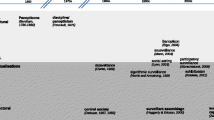Abstract
The notion of accountability was introduced by Harold Garfinkel in the opening pages of Studies in Ethnomethodology (1967) as part of his ‘central recommendation’ for sociological inquiry. Though the term itself first appears in the Studies, it will be argued that elements of the idea were already discernible in earlier writings. The current article traces the development of the notion from its early emergence in the proto-ethnomethodological period, through its elaboration in the Studies, and, finally, to its refinement in certain later works produced toward the end of the author’s career. In so doing, it reveals the centrality of the notion to ethnomethodologically-informed study and shows its enduring contribution to social theory.
Similar content being viewed by others
Notes
Though the data presented does indeed come from his dissertation research (see Koschmann 2012), it is misleadingly described in the ‘trust’ chapter as coming from an experiment conducted at UCLA.
The Garfinkel and Sacks (1970) chapter focuses exclusively on indexical expressions in natural language, but it must be borne in mind that when Garfinkel first raises the topic in the Studies it was meant to apply as well to “other practical actions” (Garfinkel 1967: 11). It is also worth noting that though Garfinkel and Sacks were only dealing with issues related to natural language here, the chapter carried the title, “On Formal Structures of Practical Actions”.
The asterisk following ‘details’ in this quote reflects a notational convention adopted by Garfinkel in EM’s Program (2002). By flagging certain terms in this way he meant for them to be read in an ethnomethodologically-inflected way, rather than in their everyday sense. This convention is, in fact, just another ‘glossing procedure’.
References
Account. (n.d.). Merriam-Webster dictionary. Retrieved July 19, 2017 from https://www.merriam-webster.com/dictionary/account.
Accountable. (n.d.). Merriam-Webster dictionary. Retrieved July 19, 2017 from https://www.merriam-webster.com/dictionary/accountable.
Accountabilty. (n.d.). Merriam-Webster dictionary. Retrieved July 19, 2017 from https://www.merriam-webster.com/dictionary/accountability.
Arminen, I. (2008). Scientific and ‘radical’ ethnomethodology: From incompatible paradigms to ethnomethodological sociology. Philosophy of the Social Sciences, 38, 167–191.
Garfinkel, H. (1952). The perception of the other: A study in social order. Cambridge, MA: Harvard University. (Unpublished dissertation).
Garfinkel, H. (1962). Common-sense knowledge of social structures: The documentary method of interpretation. In J. M. Scher (Ed.), Theories of the mind (pp. 689–712). New York: Free Press of Glencoe.
Garfinkel, H. (1963). A conception of, and experiments with, ‘trust’ as a condition of stable concerted actions. In O. J. Harvey (Ed.), Motivation and social interaction (pp. 187–238). New York: Ronald Press.
Garfinkel, H. (1967). Studies in ethnomethodology. Englewood Cliffs, NJ: Prentice-Hall.
Garfinkel, H. (1996). Ethnomethodology’s program. Social Psychology Quarterly, 59, 5–21.
Garfinkel, H. (2002). Ethnomethodology’s program: Working out Durkheim’s aphorism. Lanham, MD: Rowman & Littlefield.
Garfinkel, H., & Sacks, H. (1970). On formal structures of practical actions. In J. C. McKinney & E. Tiryakian (Eds.), Theoretical sociology: Perspectives and developments (pp. 337–366). New York: Appleton-Century-Crofts.
Helmer, O., & Rescher, N. (1959). On the epistemology of the inexact sciences. Management Science, 6, 25–52.
Koschmann, T. (2012). Early glimmers of the now familiar ethnomethodological themes in Garfinkel’s “The Perception of the Other”. Human Studies, 35, 479–504. https://doi.org/10.1007/s10746-012-9243-z.
Levinson, S. (2013). Action formation and ascription. In T. Stivers & J. Sidnell (Eds.), The handbook of conversation analysis (pp. 103–131). Oxford: Blackwell.
Livingston, E. (1983). An ethnomethodological investigation of the foundations of mathematics (PhD dissertation). CA: UCLA Los Angeles.
Livingston, E. (2008). Context and detail in studies of the witnessable social order: Puzzles, maps, checkers, and geometry. Journal of Pragmatics, 40, 840–862.
Lynch, M. (1993). Scientific practice and ordinary action: Ethnomethodology and social studies of science. New York: Cambridge University Press.
Mannheim, K. (1952). On the interpretation of Weltanschauung. In P. Kecskemeti (Ed.), Essays on the sociology of knowledge: The collected works of Karl Mannheim (Vol. V, pp. 33–83). London: Routledge & Kegan Paul.
Parsons, T. (1937). The structure of social action: A study in social theory with special reference to a group of recent European writers. Glencoe, IL: The Free Press.
Pollner, M. (2012). The end(s) of ethnomethodology. American Sociologist, 43, 7–20.
Schegloff, E. (1992). Introduction. In G. Jefferson (Ed.), Harvey Sacks: Lectures on conversation (pp. ix–lxii). Malden, MA: Blackwell Publishers.
Schütz, A. (1945). On multiple realities. Philosophy and Phenomenological Research, 5, 533–575.
Weizenbaum, J. (1966). ELIZA: A computer program for the study of natural language communication between man and machine. Communications of the ACM, 9(1), 36–45.
Wilson, T. P. (2003). Garfinkel’s radical program. Research on Language and Social Interaction, 36(4), 487–494.
Wilson, T. (2012). Classical ethnomethodology, the radical program, and conversation analysis. In H. Nasu & F. Waksler (Eds.), Interaction and everyday life: Phenomenological and ethnomethodological essays in honor of George Psathas (pp. 207–238). Lanham, MD: Lexington Books.
Author information
Authors and Affiliations
Corresponding author
Additional information
Publisher's Note
Springer Nature remains neutral with regard to jurisdictional claims in published maps and institutional affiliations.
Rights and permissions
About this article
Cite this article
Koschmann, T. Tracing the Seminal Notion of Accountability Across the Garfinkelian Œuvre. Hum Stud 42, 239–252 (2019). https://doi.org/10.1007/s10746-019-09513-7
Published:
Issue Date:
DOI: https://doi.org/10.1007/s10746-019-09513-7




